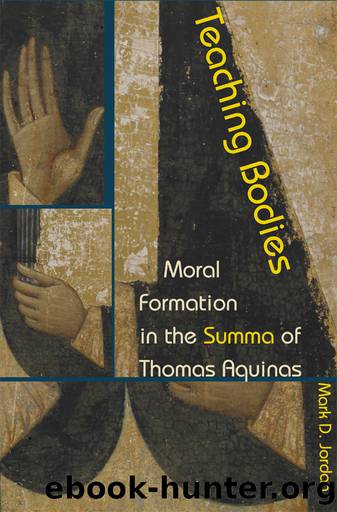Teaching Bodies by Jordan Mark D.;

Author:Jordan, Mark D.; [Jordan, Mark D.]
Language: eng
Format: epub
Publisher: Fordham University Press
Published: 2016-08-15T00:00:00+00:00
CHAPTER 8
Stages on Lawâs Way
The Summaâs questions on the sequence of laws are the most famous of Thomasâs moral texts. They may also be the most misunderstood. One reason is that readers often encounter them as contextless excerpts from which they are told to extract timeless maxims or âexceptionlessâ norms. In context, within the Summa, law teaches the embodied reader in other ways.
Thomas treats law toward the end of the first section of the Summaâs middle part. The whole section concerns the elements and motives of human action. It opens with the exhortation to the final end of all human acting. It closes by depicting the most powerful means for attaining that end, namely grace. The questions on law, which are not now and have never been a separable âtreatise,â come immediately before grace. Law and grace are paired by the Summa as incomplete and complete, anticipation and fulfillment. If grace animates the new law of Christ, earlier kinds of law prepare to be fulfilled in it.
Thomas emphasizes the pairing as he introduces this segment of the Summa. Law and grace are, he explains, external principles of human actions (2-1.90 pro). There are others. The devil is an external principle inclining human beings to evil by temptation. More important, and more consolingly, the external principles of human action culminate in God, who moves human beings toward the good. God does this in two ways: instructing by law and helping by grace.
God instructs us by law: nos instruit per legem. Thomas chooses the verb carefully. From his earlier writings forward, and often enough in the Summa, Thomas repeats that the law is for instruction.1 In Thomasâs lexicon, law is, of course, not the only thing said to instruct. Instruction is given by God, Jesus Christ, the Holy Spirit, angels, bodily creatures, revelation, apparitions, sciences, infused virtues, and even inner instinctsâto recall some frequent phrases. Still, law also instructs, and instruction is the most important thing that it does. Its pedagogical function is particularly resonant in the Summa, because the claim that God âinstructs us by lawâ recalls the workâs opening words: âSince the teacher of catholic truth should instruct not only the advanced . . .â (1 pro). Law belongs to a divine pedagogy that includes the teacher of Catholic truth. Before the reader reaches the four-part definition of law, she hears that law is an instruction given by God as an external help in the human pursuit of the good. She hears as well that it is linked to the more direct help of grace. Whatever else a reader learns about the law must be read back into that fundamental characterization, which determines its position in the Summa.
The notion of instruction conditions the meaning of another word that Thomas repeats when explaining law: praeceptum, the ancestor of the English âprecept.â In the questions on law, praeceptum functions as a genus comprising a number of species. Within the Christian Scriptures, it will name what English-speakers call the ten âcommandmentsâ but also the liturgical ordinances and political arrangements of ancient Israel.
Download
This site does not store any files on its server. We only index and link to content provided by other sites. Please contact the content providers to delete copyright contents if any and email us, we'll remove relevant links or contents immediately.
Cecilia; Or, Memoirs of an Heiress — Volume 1 by Fanny Burney(32319)
Cecilia; Or, Memoirs of an Heiress — Volume 3 by Fanny Burney(31698)
Cecilia; Or, Memoirs of an Heiress — Volume 2 by Fanny Burney(31674)
The Lost Art of Listening by Michael P. Nichols(7331)
Asking the Right Questions: A Guide to Critical Thinking by M. Neil Browne & Stuart M. Keeley(5545)
We Need to Talk by Celeste Headlee(5475)
On Writing A Memoir of the Craft by Stephen King(4797)
Dialogue by Robert McKee(4256)
Pre-Suasion: A Revolutionary Way to Influence and Persuade by Robert Cialdini(4069)
I Have Something to Say: Mastering the Art of Public Speaking in an Age of Disconnection by John Bowe(3805)
Elements of Style 2017 by Richard De A'Morelli(3268)
The Book of Human Emotions by Tiffany Watt Smith(3185)
Fluent Forever: How to Learn Any Language Fast and Never Forget It by Gabriel Wyner(2963)
Name Book, The: Over 10,000 Names--Their Meanings, Origins, and Spiritual Significance by Astoria Dorothy(2899)
Good Humor, Bad Taste: A Sociology of the Joke by Kuipers Giselinde(2845)
Why I Write by George Orwell(2840)
The Grammaring Guide to English Grammar with Exercises by Péter Simon(2668)
The Art Of Deception by Kevin Mitnick(2651)
Ancient Worlds by Michael Scott(2560)
